
An archive of articles on the silent era of world cinema.
Copyright © 1999-2025 by Carl Bennett and the Silent Era Company.
All Rights Reserved.
|
|
Desert Winds and Smouldering Fires
The 37th Pordenone Silent Film Festival
| Article Copyright © 2019 by Lokke Heiss. All Rights Reserved. |
As I write these words, I keep hearing a piano chord in my head — not just any chord, but a huge sweeping chord that resolves not only a musical scale progression but also resolves a love affair, a mystery, a tragedy.
In other words, it’s a chord played by a pianist when the climax of a silent film is reached.
As the chord reverberates through my head, images of eight days of silent film resolutions flitter by: A guy gets the girl, a guy loses the girl, a guy loses a girl but gets a ship, a guy loses his mom but saves the nation, a gal loses a guy and marries another guy who turns out to be the right guy after all, a guy loses his girl to death but gets his soul back, and finally, a guy wins at chess, loses a war, wins again at chess, and finally gets the girl after being almost executed for playing chess so well.
Where else could I have been but from the Pordenone Silent Film festival!
For thirty-seven years, a small town in Northeast Italy has held a weeklong film festival dedicated to silent movies. The original festival — a group of dedicated film collectors who got together to show each other their favorite silent film — has evolved into the most prestigious of all silent film festivals, a showcase event for film experts and enthusiasts to watch movies and talk about what they’ve seen.
The dazzling schedule this year featured films that ranged from up-close-and-personal family dramas to sweeping costume extravaganzas. The special programs this year included a retrospective of director John Stahl’s underappreciated silent films, and festival-goers this year had a special treat — a selection of films picked out by Kevin Brownlow, comprising of films he wanted to see on a big screen. Overall, we saw films of swashbuckling ships at sea, broken and mended romances, friendly dinosaurs, and phantom carriages — in other words, it was another fabulous lineup of films at the Pordenone Festival!
Epic! Eight Days of Spectacle at the Verdi
A dictionary definition describes the word ‘epic’ as ‘a long narrative poem told in an elevated style of a legendary or historical hero.’
And with these guidelines in place, silent film is the perfect medium for which an epic can be made. The key to understanding why this is true is to recognize the importance of making an epic (as the dictionary reminds us) ‘in an elevated style.’ Silent film, with its specialized forms of acting and lack of synchronous dialogue, are by definition stylized and, in that sense, already ‘elevated’ — that is, slightly removed from reality. Even more important is silent film’s affinity for live performance and musical accompaniment. With the option of multiple instruments, perhaps even an orchestra, the experience of watching a silent film becomes closer to that of attending an opera, an art form known for epic productions.
When these possibilities are utilized, silent film is more than halfway toward an ‘epic’ presentation. Then when other elements are added, such as incorporating a national myth, or a story that examines the ethics of how we should live our lives, it’s clear that silent film is tailor-made for epic presentations, and the films screened this week were examples of how a film can be more than just entertainment, but a true ‘event.’
Opening Night Film: Captain Salvation
| |
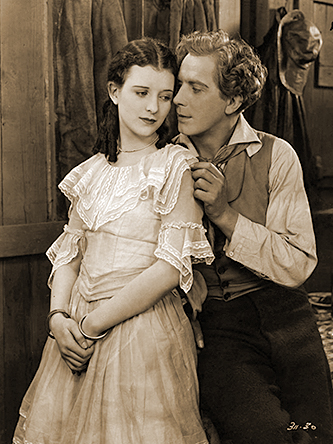 |
| |
Marceline Day and Lars Hanson
in Captain Salvation (1927).
Photograph: Silent Era image collection.
|
I can’t think of a better example of an epic story than the opening night film at Pordenone, Captain Salvation (1927). Lars Hanson stars as Anson Campbell, a young man just out of seminary, who returns to his small and provincial New England village to start his career as a priest. The town is suspicious of his attitude of tolerance in his preaching, and even more worried about his obvious interest in the sea (Campbell comes back to his town dressed as a sailor, not a clergyman). As Anson is about to propose to his childhood sweetheart Mary (Marceline Day), a storm picks up, blowing a ship into the nearby rocks. One of the few survivors is Bess (Pauline Starke), who is accused of causing the wreck because she is a ‘fallen woman.’ To the town’s anger, Anson defends Bess to the point of taking her to his home. His reputation ruined, and even rebuked by fiancée Mary, Anson takes to the sea with Bess on the first available ship.
This impetuous act has dire consequences as they find themselves to be in a prison ship, helmed by Captain George Fawcett (Ernest Torrence) a man so villainous he could have taught Jack London’s Wolf Larson some tricks. Anson is so overcome by the treachery and evil around him that his belief in God slips away, but as he loses his faith, Bess finds hers. Understanding that Anson has sacrificed everything for her, she carries the message of kindness and decency to the crew that Anson no longer believes in. Seeing Bess’s effect on his crew, and his personal control slipping away, Fawcett attacks Bess, and in a rage, Anson and Fawcett have an all-out donnybrook on the ship. The battle over, Anson must decide how to reconcile his religious convictions with his love of the sea, and comes up with an inspired solution: he decides to be captain of the first ‘faith ship,’ spreading the word of God to the high seas.
The cast is uniformly excellent. I’ve joked about Gary Cooper being the ‘American Lars Hanson,’ but the similarity between the two actors is on display with this film as Hanson essayed the type of role that Cooper would step into in just a few years.
A tall ship sailing the high seas is a perfect setting for an epic production, but that is only part of the formula. What sets Captain Salvation apart from other swashbucklers is that it takes a hard look at religious hypocrisy by those who consider themselves religious, to the point it’s hard to leave the theatre without at least some reflection of your own values.
| |
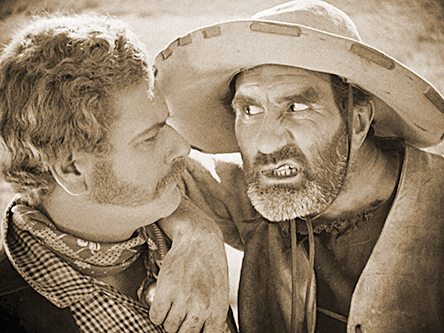 |
| |
Alan Hale (left) and Ernest Torrence in The Covered Wagon (1923).
Photograph: Silent Era image collection.
|
The second ‘big’ picture of the opening weekend — also featuring character actor Ernest Torrence — was The Covered Wagon (1923). In this film, Torrence plays trusty sidekick to the hero, Will Banion (J. Warren Kerrigan), and the film recounts the trials and ordeals of pioneers on their journey from Kansas City to Oregon. Two wagon trains merge during the trip, Will leading one, the other led by Jesse Wingate (Charles Ogle). During the adventure, Jesse’s fiancé, Molly Wingate (Lois Wilson) falls in love with Will, causing Jesse to scheme against Will until Will is dismissed from the train. Will leaves to hunt for gold in California, and Molly, realizing she loves him instead of Jesse, dispatches Jackson to find and bring back Will, producing a chain of events that lead to a rousing conclusion.
Born in 1884 to pioneer parents, and growing up in Utah only a generation removed from the events in the film, director James Cruze was determined to keep as many authentic details in The Covered Wagon as possible. In what I feel to be the most memorable scene in the story, one of the pioneers dies and is buried. As the train moves out, the wagons to roll over the grave, obscuring it from any future disturbance by coyotes or anyone looking for bounty. The images of one wagon after another rolling over a grave that that will be forever nameless, connects us to a particular detail of the American mythology of the perilous Westward journey of a family — in particular the death of a loved one (retold vividly in similar stories, such as John Steinbeck’s The Grapes of Wrath). This scene, and many others like it, give The Covered Wagon a myth-like stature and also reminds us of the importance of the film in the development of the Hollywood Western genre.
| |
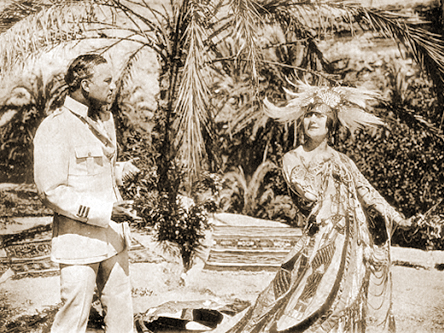 |
| |
Jean Angelo and Stacia Napierkowska in L’Atlantide (1921).
Photograph: Silent Era image collection.
|
Another very special film screened this week was L’Atlantide [Atlantis] (1921) directed by Jacques Feyder, adapted from the novel by Pierre Benoit. Filmed in Algeria in the Tuaregs of the Sahara and the mountains of Ahaggar, (with interior scenes shot under a huge tent near Algiers), Atlantis is the most realist film of its type I have ever seen. The film is a ‘Lost Race’ story about two French Legionnaires, Saint-Avit (George Melchior) and Morhange (Jean Angelo) who discover the lost city of Atlantis in the middle of the Sahara Desert (the idea being that the Sahara used to be a vast sea). The ruler of the valley and queen of her people is Antinea (Stacia Napierkowska), who is irresistibly attractive to men. Whoever she chooses is forced to become her consort, and when they die, their mummified bodies are taken to a room to join a gallery of ex-lovers. Antinea takes a liking to Captain Morhange, but when he (under great duress) resists her advances, she schemes to have him killed. Saint-Avit escapes Atlantis and return to France, but he has been ‘contaminated’ by his exposure to Antinea, and knows at some point must obey her siren call and return. When reassigned back to the Sahara, he begins the long journey to be reunited with Antinea, taking with him a young officer who has heard his story, with both men perhaps understanding the cycle must and will perpetuate itself.
The most gripping part of this film comes at the beginning and end, where the explorers endure hardship and privation in the desert. The middle section, where they find the ancient city of Atlantis, is often dazzling, but it’s hard for this section to keep up with the authenticity of desert scenes, which were filmed in an almost documentary style. For those who have seen She (a similar story) and expect to see someone like Ursula Andress, the zoftig Stacia Napierkowska may be a surprise, but it’s important to remember that tastes change. Napierkowska was well known at the time as a dancer of the Opéra Comique and Folies-Bergère, (and also incidentally Germain Dulac’s first lover), so she had real credentials as the right person for the role. This opinion is also supported by the public’s endorsement of her character, the film was a huge hit in France and ran in one Paris theatre for more than a year.
Casting and acting aside, the real star of Atlantis is the landscape, which Feyder in his meticulous and often obsessive way, lingers on to such an extent that one starts to wonder if he’s more interested in desert than the lost city of Atlantis. Then we wonder if that is the point, perhaps Antinea and her city are the personification of the even greater mystery of the desert itself. Like the characters of Morhange and Saint-Avit, we become hypnotized by the shifting sands, our minds contemplating a barren dreamscape of rolling dunes scoured by hot rhythmic winds. The best description of the film is probably from the filmmaker and critic, Louis Delluc, who wrote after its premiere, “There is one great actor in Atlantis, and it’s the sand.”
Of all the films screened this week, Atlantis may be the most fragile, in the sense it needs a huge screen and pitch-perfect accompaniment to achieve the hypnotic effect I’ve described. Since this combination may be hard to replicate, I would refer to Peter Weir’s Picnic at Hanging Rock as a point of reference.
The success of Atlantis helped ‘put the romance in the desert’ for movie audiences, thus setting the stage for future films such as Beau Geste and The Sheik. But despite many attempts, no one approached Feyder’s vision of the Sahara until David Lean gave it his best effort forty years later with Lawrence of Arabia.
Another of Kevin Brownlow’s picks for the week was The Last of the Mohicans (1920) directed by Maurice Tourneur and Clarence Brown. Tourneur, who often gets sole directing credit for this film, fell off production set scaffolding a few weeks into the filming. While Brown finished the film, the result shows a true collaboration between the two men. Adapted from the book by James Fenimore Cooper, and taking place in American’s colonial period during the French and Indian War, the story concerns the fate of two sisters Cora (Barbara Bedford) and Alice (Lillian Hall) who find themselves in the middle of a battle between the British and the French, who have enlisted the aid of the Hurons. While at a British fort, Cora meets Uncas (Albert Roscoe) and they sense an immediate affinity for each other. The women are given an Indian escort, Magua (Wallace Beery) for safe passage out of danger, however since Magua is secretly working for the French, he instead kidnaps the two women. Uncas and his friend Hawkey (Harry Lorraine) follow Magua and rescue the women, but Uncas and Hawkey are then betrayed by a British officer, causing a massacre of women and children. Cora is recaptured and finds herself cornered by Magua at the edge of a cliff just as Uncus arrives to try and save Cora, who he recognizes as having a true noble spirit which he must protect.
To appreciate The Last of the Mohicans, one must first apply context to its problematic features, which include whites playing Indians in ‘redface,’ and Wallace Beery playing an archetype of the evil, vengeful savage. Then it’s necessary to consider how national myths use and often magnify racial stereotypes. The Last of the Mohicans is a captivity narrative, which was arguably the first American genre of fiction, an updating of Old World captivity narratives that go back thousands of years. In the American version, the usual story involves women or children becoming captives of Indians, and the efforts of colonials to rescue them.
Complicating the captivity narrative is that in this version, the main hero in this story is an Indian, and treachery from a British officer is the main cause of a terrible massacre. Getting past the social politics of the film, the next element that seems shocking even today is its depiction of violence, such as the massacre scene where children are murdered. No sugar-coated romantic fantasy, Last of the Mohicans is a brutal story that ties into another myth, specifically the ‘murder of innocents,’ a narrative going back at least as far as Exodus, where first Jewish children were killed, and then first-born sons were killed as the consequence of God’s last plague against the Egyptians.
Yet all of these issues are backgrounded by the sheer pictorialism of the film itself. As described by film critic David Craft, The Last of the Mohicans is ‘so ravishing that the picture at times resembles a landscape watercolor come to life. Watching a Tourneur film like this goes beyond moving pictures; it’s like viewing the moving canvas of an old master.’ The Last of the Mohicans is available in every conceivable format, but to be able to watch a pristine print projected in ideal conditions is to appreciate a heightened visual sensibility that may have been equaled, but was never surpassed in the silent film era.
| |
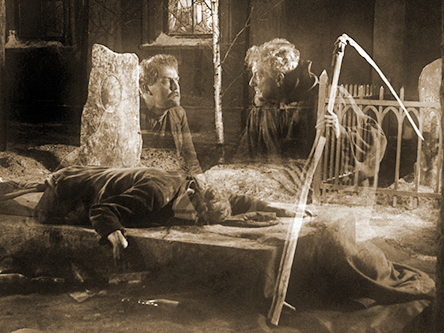 |
| |
Victor Sjöström (left) in Körkarlen (1921).
Photograph: Silent Era image collection.
|
It’s hard to pick favorites in a festival like this, but if I had to pick an ‘epic among epics,’ I would choose Victor Sjöström’s Körkarlen [The Phantom Carriage] (1921). Taken from a story by Selma Lagerlöf, The Phantom Carriage uses as its premise the legend that the last person to die on New Year’s Eve is cursed to be the new driver of Death’s Carriage and be in charge of collecting newly dead souls for the next year.
The story starts in a graveyard approaching New Year’s Eve, where an abusive alcoholic David From (played by Sjöström himself) is drinking with his friends when he learns that a Salvation Army sister Edit (Astrid Holm) who has always believed in him, is dying of consumption, an illness he gave her. Refusing to see her, he fights with his buddies, is knocked out, and while unconscious, meets the driver of Death’s carriage, who takes him on a tour of David’s wretched, misspent life. During this tour, David learns he is to die tonight at the stroke of midnight and is destined to be Death’s driver for the next year. Seeing the destruction and damage to others he has caused, as the clock strikes midnight, David must decide if he can honestly commit to reform.
Handling a complex narrative structure with a fluidity that one appreciates more with each viewing, what impresses me most about The Phantom Carriage is the intensity of feelings this film generates for those who open to its message. Its similarity to Charles Dickens’ A Christmas Carol is obvious, but Ebenezzer Scrooge is a piker compared to David From. In a key scene, the Salvation Army nurse Edit takes in a battered and exhausted David for a night’s lodging, and while he sleeps, she mends his coat, sewing his buttons. In the morning, in an act of defiance, Victor makes her watch him tear the buttons off before he leaves. Scrooge was a cruel, heartless miser but understood the value of money. David has sunk to a far lower state, rejecting acts of mercy and despising everyone, most of all himself.
As inspiration, The Phantom Carriage is an ur-text for filmmakers around the world, we see its influence in films ranging from Capra’s It’s a Wonderful Life to Kubrick’s The Shining (there is a scene in The Phantom Carriage where David, in a rage, axes in a door. Kubrick in an homage to Sjöström, duplicates the scene). The Phantom Carriage was also a major influence to Ingmar Bergman, who called it the ‘film of all films,’ and watched it yearly. Bergman would incorporate its themes into his work, using Death as a character in The Seventh Seal, and in Wild Strawberries, he cast the elderly Sjöström as a man who is reflecting on the pain he has caused others over his life.
For its elevated stature in film history, one wonders why The Phantom Carriage is rarely screened in theaters; perhaps its message is too intense and complex for casual viewing. I, for one, would love to see the film added to Christmas/New Year’s Eve end-of-year holiday events: If we can have A Christmas Carol as part of our yearly holiday diet, I can’t think of a better New Year’s Eve spent watching another splendid ghost story, The Phantom Carriage.
The last epic discussed in this festival review is The Chess Player and will be discussed in the Closing Night Film section.
John M. Stahl — The Silent Years
| |
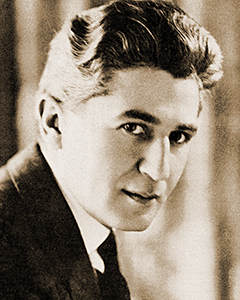 |
| |
John M. Stahl.
Photograph: Silent Era image collection.
|
When a year before, the Pordenone announced a program of John Stahl films, many of us looked at each other, shaking our heads in ignorance. John Stahl is better known for his melodramas made in the Classic Hollywood Era, such as Imitation of Life and Leave Her to Heaven. Stahl however, started making films as early as 1913, and his silent film period has been woefully neglected. To correct this mistake, Pordenone and the Bologna Film Festival have teamed up in an effort to make his earlier films available for viewing.
John Stahl, born in Baku with the name of Jacob Morris Strelitsky immigrated with his family to New York at the turn of the century. As a young man, he became involved in the film industry and directed his first film in 1913. Of his 22 silent features, at least 12 survive. His earliest surviving films are a series of short films about Abraham Lincoln, The Lincoln Cycle (1917).
The surprise hit of this year’s festival is John Stahl’s The Lincoln Cycle (1917). Stahl’s name does not appear in any of the credits for these films, probably because the actor playing Lincoln (Benjamin Chapin) was adamant about taking as much credit for the production as he could. Quiet about other aspects of his young life (such as being born in the Russian Empire), Stahl claimed credit for directing The Lincoln Cycle, a claim that Chapin never denied.
The Lincoln Cycle is a series of stories about Lincoln’s childhood. Importantly, they are framed as reminisces, usually told by Lincoln himself, about important events that happened when he was a boy. Interestingly, the films give space to alternate views of an event — sometimes the story is told not by Lincoln but by one of his friends, or occasionally even a rival. Watching the series from one story to the next adds to the experience, as we build a Rashomon quality to the tales being told. Lincoln does not always remember an event in the same way, and a careful viewer will see that his flashbacks often incorporate unused footage previously seen in a prior episode, giving us a different point-of-view of the event in the most literal sense possible.
| |
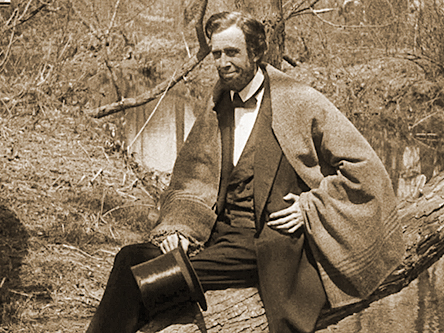 |
| |
Benjamin Chapin in The Lincoln Cycle (1917).
Photograph: Silent Era image collection.
|
An example of this ‘layering effect’ works is to compare ‘Lincoln’s Mother,’ the first film in the series, with ‘Tender Memories,’ a later film in the cycle. ‘Lincoln’s Mother,’ which features Madelyn Clares, shows how the young Lincoln (Charlie Jackson) used his mother’s teaching as a guide to navigating the ethical questions he faced on his road to the presidency. The book learning she gave him was important but even more important, the episode tells us, was that his mother taught him a moral code that included tolerance of others, and the meaning of right and wrong.
As a young boy, Abraham had a quick temper, which caused him to get into fisticuffs with other boys and the last message she had to tell him before she died of milk fever poisoning was how important it was not to get into a fight. As the episode ends, the adult Lincoln finishes his story of how his mother was everything to him, and then he thinks about the impending Civil War, his face saddens. He’d strived each day to keep his promise to his mother not to get into a fight, and here he was, about to lead the United States into war. Despite all he could do, he still wasn’t able to keep his promise to her. Intellectually, he knows the war is needed, but emotionally, Lincoln is thinking he has failed his mother once again.
In a later episode, ‘Tender Memories,’ President Abraham Lincoln, near the battlefront, watches a soldier bury his friend. Lincoln consoles him, telling him how hard it was to bury his own mother. As he tells his story to the soldier, we see a flashback of a young Lincoln, clawing at the freshly turned earth of the newly buried grave of his mother, asking, begging, for a priest to come and give his blessing. These episodes, along with the other short films in this cycle, are a powerful reminder to us how the past is always part of who we are, or as William Faulkner put it: “The past is never dead, it’s not even past.”
Films are complex productions involving a team of artists, and in any such group effort, a lot can go wrong. In many films, some scenes work better than others, leaving one sometimes to sum up a film by saying ‘the parts are greater than the whole.’ The Lincoln Cycle is one of those rare films where ‘the whole is greater than the parts,’ because the series gathers power in its unique approach to a historical figure. Instead of a booming, authorial voice informing us why he was a great man, we have a series of flashbacks structured as parables, giving us a ‘bits-and-pieces’ explanation how Lincoln became the person he was, a much richer experience for the audience. Allowing for the unfortunate missing films in its sequence, the cycle is a unique event for a silent film fan and a must for any Lincoln or Civil War enthusiasts.
The list of the original ten episodes: ‘My Mother, My Father,’ ‘The Call to Arms,’’ ‘My First Jury,’ ‘Tender Memories,’ ‘A President’s Answer,’ ‘Native State,’ ‘Down the River’ (missing), ‘The Slave Auction’ (missing), ‘Under the Stars.’ All surviving episodes were screened the week of the festival.
| |
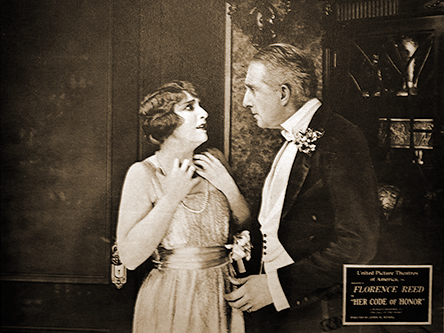 |
| |
Florence Reed and Alec B. Francis in Her Code of Honor (1919).
Photograph: Silent Era image collection.
|
Along with The Lincoln Cycle, eight of Stahl’s surviving silent films were also screened. Her Code of Honor (1919), the first feature film of Stahl’s to survive, is the story of an art student Helen (Florence Reed) who while in Paris, turns away the attention of a suitor Tom Davis (Alec Francis), who she considers a friend, and instead has an affair with Jacques (Irving Cummings). Helen finds herself pregnant, but when she goes to Jacques to tell him, he discovers he is married. Tom has returned to the States and takes on the responsibility of raising Helen’s child, Alice, after Helen dies. Many years later, Alice falls in love with Eugene LaSalle, but finds out he may be a son of Jacque, which would mean she and Eugene would both have the same father. As they already have been lovers, the couple considers suicide as a way out of their hopeless dilemma.
As polished as Stahl is in presenting this complicated dilemma, Her Code of Honor is interesting in that — released in the year 1919 — it still shows its Victorian stage melodrama roots. The Parisian father of the child, Jacques, may not twirl his mustache, but he’s a cad just the same, and the plot advances by a series of coincidences, resolved by yet another coincidence.
Stage melodramas of the Victorian era had clear heroes and villains, but by the 1920s, these stock characters were already being made fun of in the movies. The modern definition of melodrama typically concerns family conflict, but the inherent difficulty of writing a melodrama without stock villains is that family conflict typically has no one to clearly root for and hate, at least no one as clearly identified as someone who would use the lines, ‘my hero,’ and ‘foiled again.’ In other words, the challenge of writing the kind of story that Stahl would specialize in is: How do you create a dramatic conflict between reasonably normal people who aren’t out to steal or hurt anyone? A much-used plot device to achieve this is for one of the characters to withhold information, thinking that doing so would be best for everyone. Coincidences were still used, sometimes cleverly, other times in jaw dropping fashion, and factoring in a war or a terrible accident to create potential death or injury for the characters was always fair game for the melodrama writer.
A film that checks off all these melodrama boxes is Stahl’s The Child Thou Gavest Me (1921). On the day of her marriage, Norma Huntley (Barbara Castleton) tells her finance Edward Berkely (Lewis Stone) that she had previously had a child out-of-wedlock that died after birth. After the ceremony, it’s revealed that the child is still alive, and in a rage, Berkely vows to kill the man who dishonored his new bride, and his suspicious mind concludes that a family friend, Tom Marshall (William Desmond) is the guilty party, Norma is the father of the child, and when he finds them together, his anger boiling over, Berkely shoots Tom. As Tom is being treated for what may be a fatal wound, a tearful Norma reveals that the father of the child was a soldier that raped her when she was serving as a nurse in Belgium and because the action happened in the darkness of night she never saw his face. Berkely realizes that he is that soldier that perpetrated the crime — which means he himself is the man he has sworn to kill. While Berkely considers shooting himself, a distraught Norma must face the reality of being married to a man who has previously caused her terrible anguish. Melodrama fans, eat your heart out.
| |
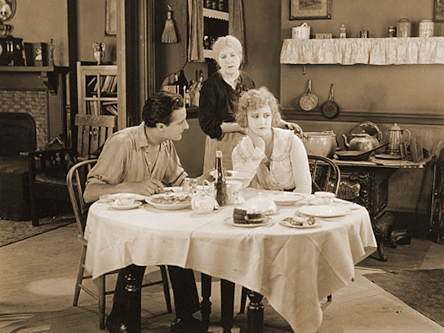 |
| |
The Song of Life (1922).
Photograph: Silent Era image collection.
|
Most of Stahl’s films screened this week were family dramas set in high society, but The Song of Life (1922) was an excursion into the world of the men and women who were just one paycheck away from going hungry. Promoted with the catchphrase ‘A drama of dishes and discontent,’ (thus anticipating the British ‘Kitchen Sink’ films of the 1950s), The Song of Life follows a woman so unhappy with her squalid existence in a Western desert town that she abandons her son to escape to New York. Years later she meets her now-adult son. David (Gaston Glass) who is now married and has by the greatest of coincidences, taken the apartment below hers. Not knowing they are related, she becomes friends with the couple, who are having a hard time financially staying above water. David is a writer, trying to finish an autobiographical novel about of all things, a deadbeat mother, who cared so little for her son that she abandoned his while he was just a child. By this point of the story, it is clear that Song of Life is working on several levels, first, of course, a melodrama, but also as a critique of the genre of melodramas (to the point the film gets close to being a spoof of itself), and finally it has elements of a social realism film, outlining the limited options of women trapped by poverty. These ideas don’t always combine well with each other, but if the film ends up as a jumble of different interests, it is still very entertaining.
Melodramas don’t have to rely on spectacular coincidences, and one of my favorite films from this program, Memory Lane (1926) succeeds by presenting a small town two-suitor romance that seems believable from start to finish. Mary (Eleanor Boardman) falls in love with Joe (William Haines), but Joe is lacking in self-confidence-feeling he’s too poor and uneducated for her, he leaves for the city to find his fortune. Giving up on Joe after a long absence, Mary starts to date the rich boy in town Jimmy (Conrad Nagel) and they announce their engagement. Joe returns to find his spot taken by a rival, and in a moment of confusion during Mary’s wedding, when Joe is assumed to be the chauffeur driving the newlyweds, Joe kidnaps Mary to take her away from Jimmy. Eventually, Joe realizes the rashness of his action and lets her go free, and leaves town. Many months later he returns, but seeing that Mary is now happy with Jimmy, before he leaves again, this time for good, he makes a scene with Mary, displaying his boorishness and unsuitability as a husband. Jimmy, however, is not fooled, he knows Joe is putting on an act so Mary will never have second-thoughts about her choice of husbands.
As I’ve written previously, it’s hard to write about conflict where there are no clearly defined good or bad characters, and when you eliminate plot devices like coincidences, the difficulty of writing a melodrama script becomes even harder. Memory Lane sails through these difficulties with ease, and the story becomes more pleasing because you don’t know how the romantic triangle will be resolved, or even who to cheer for. Only when Joe gives Mary up to Jimmy do you realize this story has never been a two-suitor romance, the opponent in this story has always been Joe against himself, and he will leave town finally with confidence in himself, knowing he is a good man who has done a good deed. This wonderfully scripted and directed film is one of the ‘discoveries’ of the festival.
| |
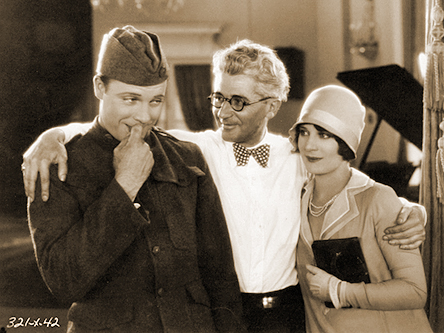 |
| |
James Murray (left) and Helene Costello in In Old Kentucky (1927).
Photograph: Silent Era image collection.
|
Stahl’s last silent film was In Old Kentucky (1927), which also featured actors James (The Crowd) Murray and Stepin Fetchit (Lincoln Perry). James Murray plays Jimmy Brierly, a happy-go-lucky son of Kentucky horse breeders. One of their horses Queen Bess shows great promise but is injured, and it appears her racing career is over. Meanwhile, Jimmy’s father has incurred severe gambling debts to the point that the family fortune is lost and the horses must be sold off, including Queen Bess who is purchased by the Army. Jimmy goes off to the Great War and while lost in no-man's-land, is surprised to find Queen Bess, who has been abandoned by his unit. Rising to the challenge, Bess races through explosions, bullets, mud, and mayhem, and delivers Jimmy back to his outfit.
The war is finally over, and Jimmy is mustered out, but by now he is suffering from shell shock. Embittered, his life is reduced to drinking and playing cards. Just as Jimmy and his family are at the point of total despair, Jimmy finds bruised and battered Queen Bess and buying her back from her owner, nurtures her back to health. On a wing and a prayer, Bess is entered into the Kentucky Derby, and when the torrential rain comes, their prayer is answered, because the one thing Jimmy knows for sure is that Bess runs well in the mud. Queen Bess pulls off a miracle upset and Brierly family fortunes are reclaimed.
Reactions to this film at the festival ranged from pleasure to dismay. An obstacle to enjoying In Old Kentucky is the treatment given of Stepin Fechit’s romance with his fiancée, Lily May (Carolynne Snowden), who is presented as comic relief to the completely conventional romance between Jimmy and Nancy Holden (Helene Costello). I saw the romance between as a positive part of the movie — within the boundaries of the era the film was made, Stahl has invested these characters with vitality and charm, and I was far more invested in their outcome than any of anyone else. Finally, In Old Kentucky, (silly plot conventions aside) has a melancholic quality that separates it from a routine programmer; Jimmy and Queen Bess are both scarred survivors from WWI, and even a fantasy-like redemptive ending does not discount the pervading sense of loss that permeates the rest of the film.
From the first of his films screened this week, The Lincoln Cycle to his last, In Old Kentucky, Stahl reveals himself as a director who reminds me of the motto: People Over Things — he is less concerned about what happens in the films he directs than its effect on the person it happens to. Above all else, Stahl has a deep interest in how we become alienated from each other, and what we can do to repair ourselves after it happens.
Other Melodramas
| |
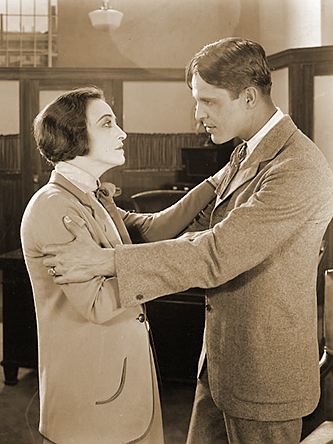 |
| |
Pauline Frederick and Malcolm McGregor
in Smouldering Fires (1924).
Photograph: Silent Era image collection.
|
Kevin Brownlow’s program of ‘films he’d like to see on the big screen’ were not only epic productions, also on his list were melodramas, such as Smouldering Fires and The Home Maker. Smouldering Fires (1924), directed by Clarence Brown is a romance between a woman who has inherited a factory from her father, and one of her employees. Jane Vail (Pauline Frederick) is the factory owner, and she singles out a smart and competent young man, Robert Elliott (Malcolm McGregor) to be her secretary. Rumors fly, and Robert, more out of respect for Jane than for love, asks her to marry him. The difficulty of the situation worsens when Jane’s sister Dorothy (Laura La Plante) comes back from college, and Dorothy and Tom feel a natural attraction to each other, and Jane begins to suspect her husband is not only in love with another woman but her own sister!
What makes Smouldering Fires so successful is that director Clarence Brown frames the situation in a sympathetic light for all the characters, refusing to play any scene for laughs or ridicule. The result is about ordinary people trying to come to terms with a situation that will involve difficult and painful choices.
Another melodrama in Kevin Brownlow’s list was The Home Maker (1925). Directed by King Baggot, this domestic drama involves a husband Lester Knapp (Brook) who is unhappy at the office and his wife Eva (Alice Joyce) who is unhappy being a housewife. Lester wasn’t cut out for managing numbers (perhaps prefiguring a condition what we would now call dyslexia) and his mistakes eventually cost him his job. Depressed and despondent, Lester impulsively decides to jump from a roof, thinking his wife will collect his insurance money. But his fall of the roof is only half-successful, instead of being killed he is only crippled, and not being able to walk, he becomes an invalid at home, his wife taking a job to make ends meet for the family.
In what contemporary Hollywood filmmakers would call a ‘plot reversal,’ as Lester starts to be able to get around in his wheelchair and be productive at home, Eva finds that she has a business talent, and soon both partners in the marriage find themselves happy in their new vocations, Lester as a stay-at-home dad, and Eva as a savvy, successful businesswoman. Then one day Lester finds himself getting strength back in his legs. Normally this would be a cause for celebration, but instead, Lester is scared: If he’s able to walk again, will that mean that he and his wife will have to return to jobs they both hate?
The ridiculous notion that Lester should have to despair at such good news — the harm caused by societal stereotypes related to both gender and vocation is the point the movie is trying to make. But instead of a polemic treatise, The Home Maker uses persuasive narrative, (like Charles Dickens used so effectively), deftly guiding us through the story so that by the conclusion of the film, one would have to be made of stone to be immune to its message.
Rin-Tin-Tin Award
Each year as part of this review I give an award to the best animal actor that has been part of the festival. This year, the nominations are:
Queen Bess: Rarely has a horse been asked to have such a range of performance duties as Queen Bess does In Old Kentucky. Bess is asked to play a young filly, a potential champion racehorse, a lame horse put out to pasture and then sent off to war, (where she saves her former owner from death), an even more broken-down horse only a half-trot away from the glue factory, and finally a champion ‘mudder’ so talented that she wins the Kentucky Derby! That’s a lot to ask from any horse, but Queen Bess hands the role with complete aplomb, believable from start to finish. Seabiscuit fans, here’s a movie for you!
Gertie the Dinosaur: An animated entry in this year’s Rin-Tin-Tin Awards is Gertie the Dinosaur.
In the Jonathan Dennis lecture, film historian Donald Crafton discussed its animator Winsor McCay and the laborious process of how Gertie was created. This animated film pioneered numerous technical advances, such as the use of registration marks and animation loops. But more important was the life McCay gave Gertie: she has a coltish, playful exuberance that captures the immediate attention of anyone watching. Meant to be exhibited with a speaker who talks to the audience through the film, the film is designed to look like Gertie is responding to the commands of its master. The effect is so effective that this interactive component gives Gertie the Dinosaur an interactive component, making this groundbreaking animated film feel contemporary.
| |
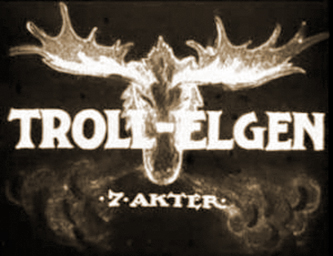 |
| |
Frame enlargement: Silent Era image collection.
|
But the winner of this year’s Rin-Tin-Tin Award is the majestic elk who gets to play the role of a lifetime, a role that I would describe as ‘Moby Dick with antlers,’ in a Norwegian film, Troll-Elgen [Ghost Elk] (1927).
In a small village on winter nights, hunters gather around the fire to talk about a mysterious creature that lives in the woods, an elk so swift and evasive that it cannot be hunted or killed. Some villagers think it has supernatural powers, perhaps it’s not really an elk but a man who died and has come back in the form of an elk to haunt the woods. Everyone agrees that to bring down this beast would be the ultimate test of manliness. In the past, one hunter, Gaupa, had come close, tracking the elk with ultimate patience, but just as he was pulling the trigger, he slipped, falling down a cliff and severely injuring himself. Gaupa has never been the same since, perhaps from the head injury he suffered . . . or was it because his contact with a demon having supernatural powers has made him a little crazy?
His friend, Hans is a poor man who is in love with Ingrid, daughter of Hallstein, a rich farmer. Hallstein has no intention of giving his daughter to Hans, and he sends him away, derisively telling Hans he’ll have to bring down the ghost-elk before he would consent to the marriage. Hallstein plans instead for Ingrid to marry the rich horse traitor Gunnar. During a town festival, Hans and Gunnar get into fight and Gunnar accidentally wounds himself. Not being able to prove his innocence, Hans runs away to the big city, where he takes refuge in a carnival. Ingrid, in love with Hans, and upset at what has happened, also travels to the city; not knowing of the presence of the other, they spend time in the city, almost circling each other’s paths before each decides their fate awaits them back in the village. Hans knows his only chance to win Ingrid is to kill the elk, seemingly an impossible task until the half-mad Gunnar reveals a secret: He has a silver bullet that can kill the Ghost-Elk (perhaps that’s what Captain Ahab needed, a silver harpoon). Properly armed, Hans sets off to hunt the ghostly creature, his fate with Ingrid will depend on whether or not he can complete the quest.
This ‘impossible task’ story has much in common with other Swedish films of this decade, combining the quest myth with a country-to-city interlude that guides the couple toward adulthood, naïve young Hans must journey to city to gain experience which he gets by working in the carnival, more mature he can return to the country and fulfill his destiny (Ingrid also travels to the city for a similar experience, they both return with a wider perspective about the world). This section of the film also has a thematic connection to Murnau’s Sunrise, where the city offers a location where the couple gain experience in the social world that gives them wisdom about each other.
Ghost Elk is beautifully photographed and the lighting and blue tinting bring an eerie, other-worldly sense to the Norwegian winter landscape. Rin-Tin-Tin tells me he has great respect for elk and is happy to find a film where one not only plays a featured role but is in fact, the star!
The Closing Night Film: The Chess Player
The mid-to-late 1920s marked the peak of French silent film historical epics, the granddaddy of them all being Abel Gance’s Napoleon. For these few special years, the talent, the budget, and audience interest all came together to make films like tonight’s closing presentation, Raymond Bernard’s Le Joueur d’échecs [The Chess Player] (1927).
A historical fantasy, The Chess Player was inspired by what might be the most successful magic act of its day, a chess-playing automaton called the ‘Turk.’ Originally designed by eccentric inventor, Wolfgang von Kempelen, and more properly described as an illusion act, the apparatus consisted of a large cabinet, on top of which was a life-size model of the chest and head of a man wearing a turban. Kempelen challenged spectators to play against the Turk, and those who did quickly found they were playing against an expert player. The trick to the act involved using a magician’s trick to hide the player in the cabinet and use of mechanical devices that allowed him to see the board and move pieces.
The act was a great success, and for decades the Turk toured Europe, playing against personages as famous as Napoleon and Benjamin Franklin. When Kempelen died, other promoters took over the act and for more than seventy years, the Turk toured across countries, finally making its way to America, where finally in 1854 it burned in a fire.
Over the years, many legends were told about the Turk, including the time it was once used to spirit a patriot out of Poland. Another legend is that when it played Napoleon, the emperor cheated, causing the automaton to sweep the pieces off the board with his arm. Building on these legends, screenwriter Dupuy-Mazuel created the story of a Polish soldier, Boleslas Vorowski (Pierre Blanchar), who is friends with an eccentric but talented inventor Kempelen (Charles Dullin). Boleslas is a good soldier but a better chess player, a truly great talent.
Neither his skills as a soldier or chess player are of much use when the Poles stage a revolt against a large, well-provisioned army belonging to Catherine the Great of Russia. Hopelessly outnumbered, the Polish revolt is crushed. Injured, and in danger of being shot on sight, Boleslas flees the battlefield, finding refuge with Kempelen.
Kempelen, trying to come up with an idea of how to smuggle Boleslas out of the country, comes up with a brilliant plan — he builds an automaton, not just any clockwork machine, but one who appears to play chess. Because Boleslas is such a good player, Kempelen reasons that they will be a success, tour Europe and by hiding Boleslas in the cabinet, smuggle him out of Poland.
But the plan is too successful. After hearing of the amazing abilities of the Turk, Catherine the Great herself commands that it be brought to her court so that she may play against it. Kempelen and Boleslas have no choice and they are taken to Moscow, and Boleslas, in his role as the Turk, finds himself in the ultimate peril as he plays chess with the capricious and vengeful Catherine the Great.
The Chess Player, coming toward the end of the silent era, is completely attuned to all the elements of what makes for a great silent film experience. It has spectacle, it has romance and mystery, and surprisingly, The Chess Player has scenes so scary they rival any horror film, including a moment when a soldier mistakenly enters Kempelen’s lab of automaton experiments. As he unwittingly activates the mindless machines who circle around him, we see a prefiguring of at least three different Twilight Zone episodes.
With consummate skill, The Chess Player throws all these forces into play with a whirlwind of action and a rousing finish. It’s a great film to end a great festival.
Conclusions: If one wants to come up with a list of reasons why a festival like this needs to exist, one needs only to consider this year’s festival program. Two reasons stand out: 1) To show the Big Picture (the epic) in a way that allows an audience to appreciate the film in ways impossible in other formats. Of particular note is that the opening and closing night films had a full orchestra, (the Orchestra San Marco of Pordenone) for both performances. The opening night film, Captain Salvation, had a score composed and directed by Philip Carli, and the closing night film, The Chess Player, had a score composed by Henri Rabaud and directed by Mark Fitz-Gerald. Earlier, I mentioned silent film’s affinity for the live performing arts, in particular, opera, and these two evenings showed the value of having a full orchestra to showcase a film designed as a special event. A festival like Pordenone provides us a chance to see these films in optimum conditions and allows a glimpse of how special opening nights must have been for these productions almost a century ago. 2) To allow an audience to see and compare films from a particular director over the period of a week, many of which are not available by any other means. The attendees at this year’s festival can attest to how successful these programs played out. The phrase I heard constantly repeated this year was, “Wow, you couldn’t see this in any other place!”
And finally, if looking for any reason to be at this year’s festival, there was no need to look further than the list of films personally curated by Kevin Brownlow himself. Brownlow’s game-changing book, The Parade’s Gone By, woke up the film world to the need for proactive efforts at film preservation. In this year’s festival, with his guidance, the parade did not pass by, but instead, for one week took up residence with us at the Verdi Theater. The festival took place on 6-13 October 2018 in Pordenone, Italy.
|




































